Everything You Need to Know About Average Reading Speed

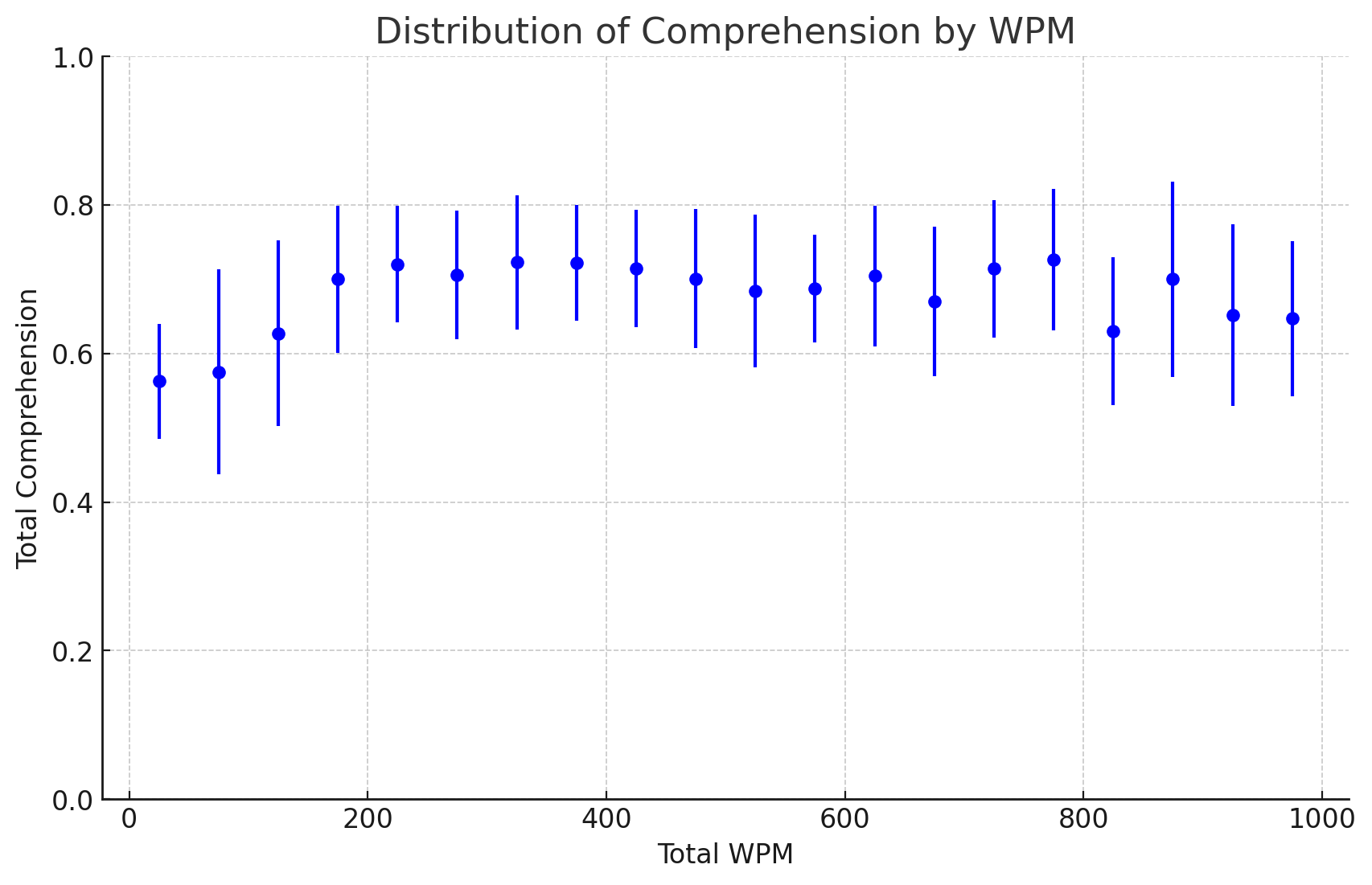
Table of Contents
Reading is a fundamental learning skill that we use every day, whether it's for work, school, or for fun. One aspect of reading that often goes overlooked is speed. We all learn how to read as young children, but many of us don’t really have the opportunity to learn how to improve our reading ability as adolescents or adults. How well you can read greatly impacts your ability to absorb information and stay productive.
In this blog post, we’ll talk about the average English reading speed and how it varies by age group and comprehension requirements. At the end, we’ll also introduce techniques and tools to help you improve your reading speed, if you so choose to. Whether you're a student, a professional, or just someone who loves to read, this post is for you.
What is the average reading speed?
The average adult reading speed is 238 WPM (words per minute) for non-fiction and 260 WPM for fiction, according to a meta-analysis of 190 different studies with 18,573 participants (Brysbaert, 2019). These numbers are for silent reading of English text by native English speaking adults.
We can better understand reading speeds, and where we or a loved one stands, by looking at how average reading speed changes with age.
Reading Speed Rapidly Improves During Childhood
Average reading speed improves rapidly as children advance through school, going from about 115 WPM in Grade 2 to 197 WPM in Grade 12, the end of high school (Spichtig, 2016).
The graph below shows how average reading speed improves throughout the schooling years in more detail. It also shows that the range of reading speeds for a given grade-level is quite large. Children experience large differences in socioeconomic background, home environment, neurodiversity, and even reading instruction methods, which all affect reading ability, and thus measured reading speed.
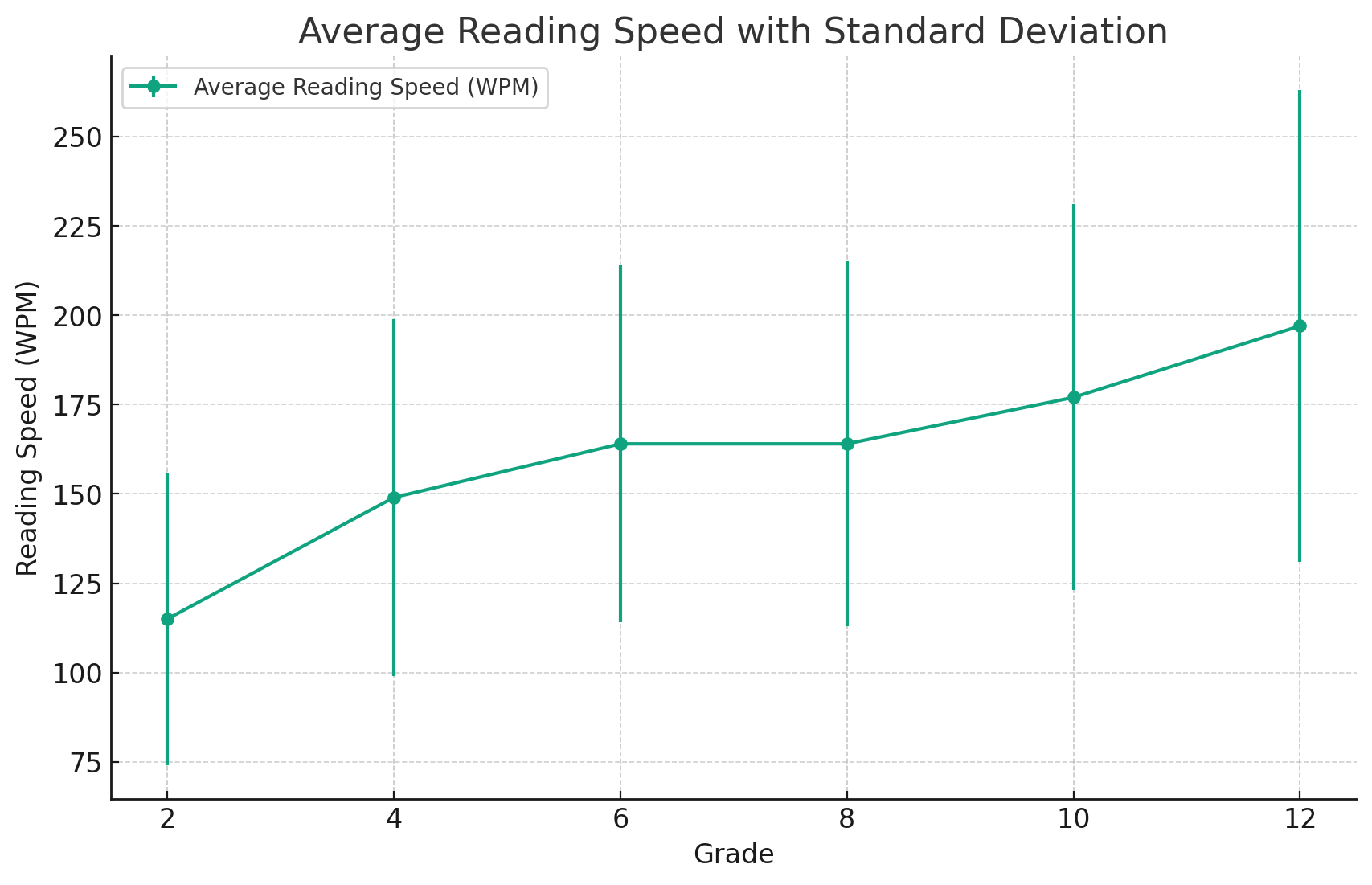
| Grade | Average Reading Speed (WPM) | Standard deviation |
|---|---|---|
| 2 | 115 | 41 |
| 4 | 149 | 50 |
| 6 | 164 | 50 |
| 8 | 164 | 51 |
| 10 | 177 | 54 |
| 12 | 197 | 66 |
It’s also important to note that the above data for reading speed by grade-level only looks at students who were able to read at 70% comprehension or better, on passages that were at their grade-level. The 70% comprehension minimum, meaning that a reader comprehended most of what he/she read, provides a reasonable standard for measuring reading ability.
Unfortunately, challenged readers (such as those diagnosed with ADHD, dyslexia, etc.) are more likely to have worse than 70% comprehension, and also lower reading speeds. So, the true average reading speed, inclusive of all readers regardless of comprehension level, is likely lower than reported by the research.
Reading Speed Plateaus in Adulthood
The average adult reading speed is 238 WPM for English non-fiction and 260 WPM for fiction, according to a meta-analysis of 190 different studies (Brysbaert, 2019). The average adult reading speed stays relatively constant until age 40, where it starts to decrease slightly due to age-related cognitive and visual decline (Calabrese, 2016).
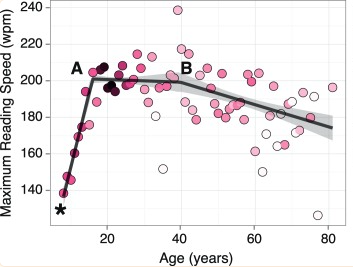
Adult Reading Speeds Vary A Lot
There isn’t much research out there on the distribution of adult reading speeds, especially by comprehension level. For example, how much does adult reading speed vary? Do some adults actually read at 400 WPM, 600 WPM, or even faster? And what does the average adult reading speed look like when there’s a 70% comprehension minimum? Because reading super fast isn’t very useful if you aren’t able to comprehend what you’re reading.
To start to answer these questions, we can look at the data from SwiftRead’s own reading speed tests.
The following data are from SwiftRead reading test results across 2,768 people. When a user takes a SwiftRead reading test, they are presented a random reading passage from our database of more than one thousand reading passages, and then asked a series of questions that test their comprehension of the reading passage.
While age data was not collected, it’s reasonable to assume that the data is representative of adults, since the reading tests in the dataset are at a high school difficulty. Also, SwiftRead’s reading tests are accessed via the internet and SwiftRead’s downloadable reading assistant software, which is mostly used by adult college students and professionals.
We exclude outliers to arrive at a more representative dataset (more about our methodology below). In our dataset, most people (the middle 50%) have a reading speed between 235 WPM and 460 WPM, with a median of 334 WPM.
From the histogram and cumulative distribution graphs of reading speed, we see that WPM reading speed is quite variable, with a right skewed distribution. 36% of people in the dataset read faster than 400 WPM (red dashed line), and 11% read faster than 600 WPM (green dashed line).
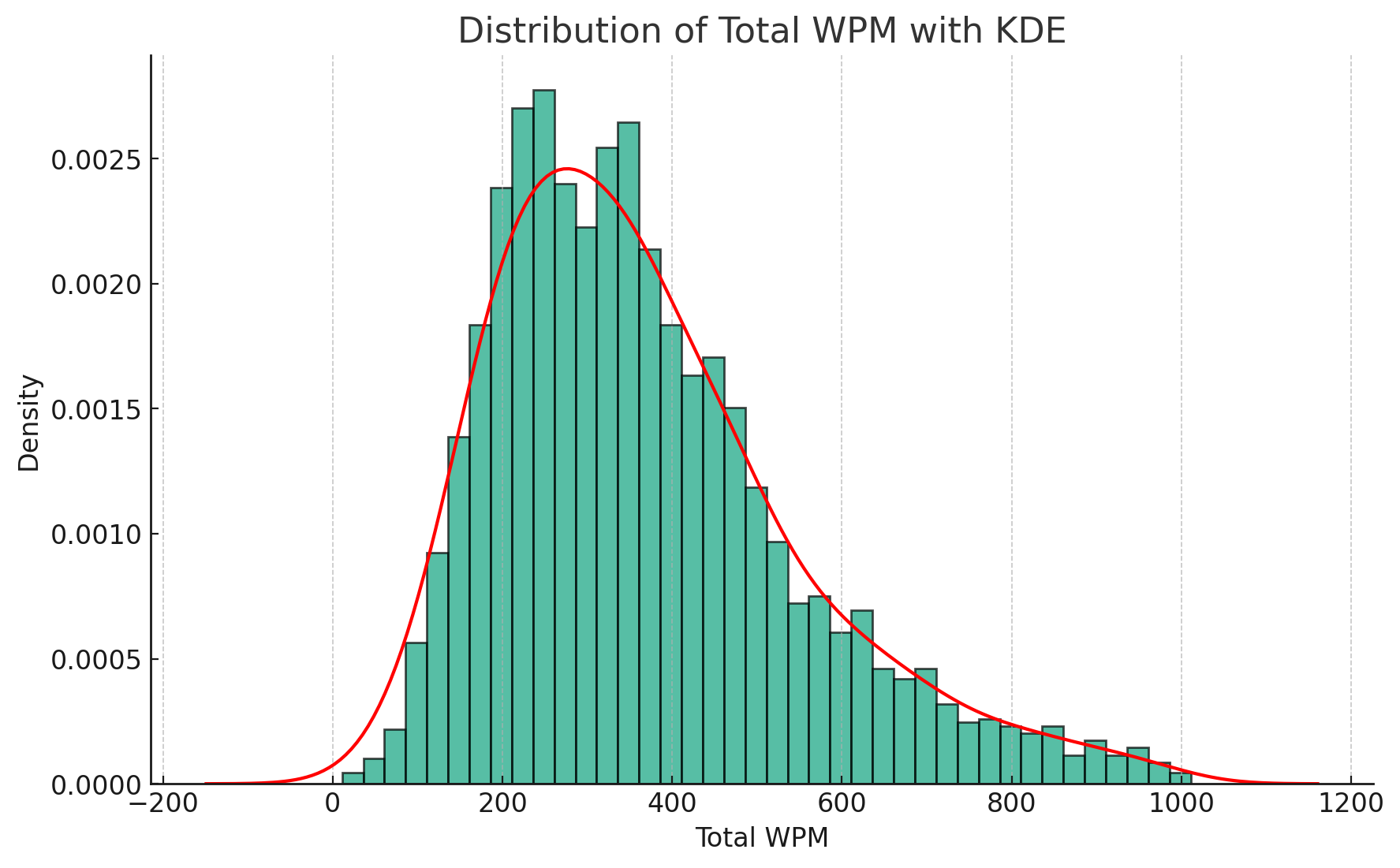
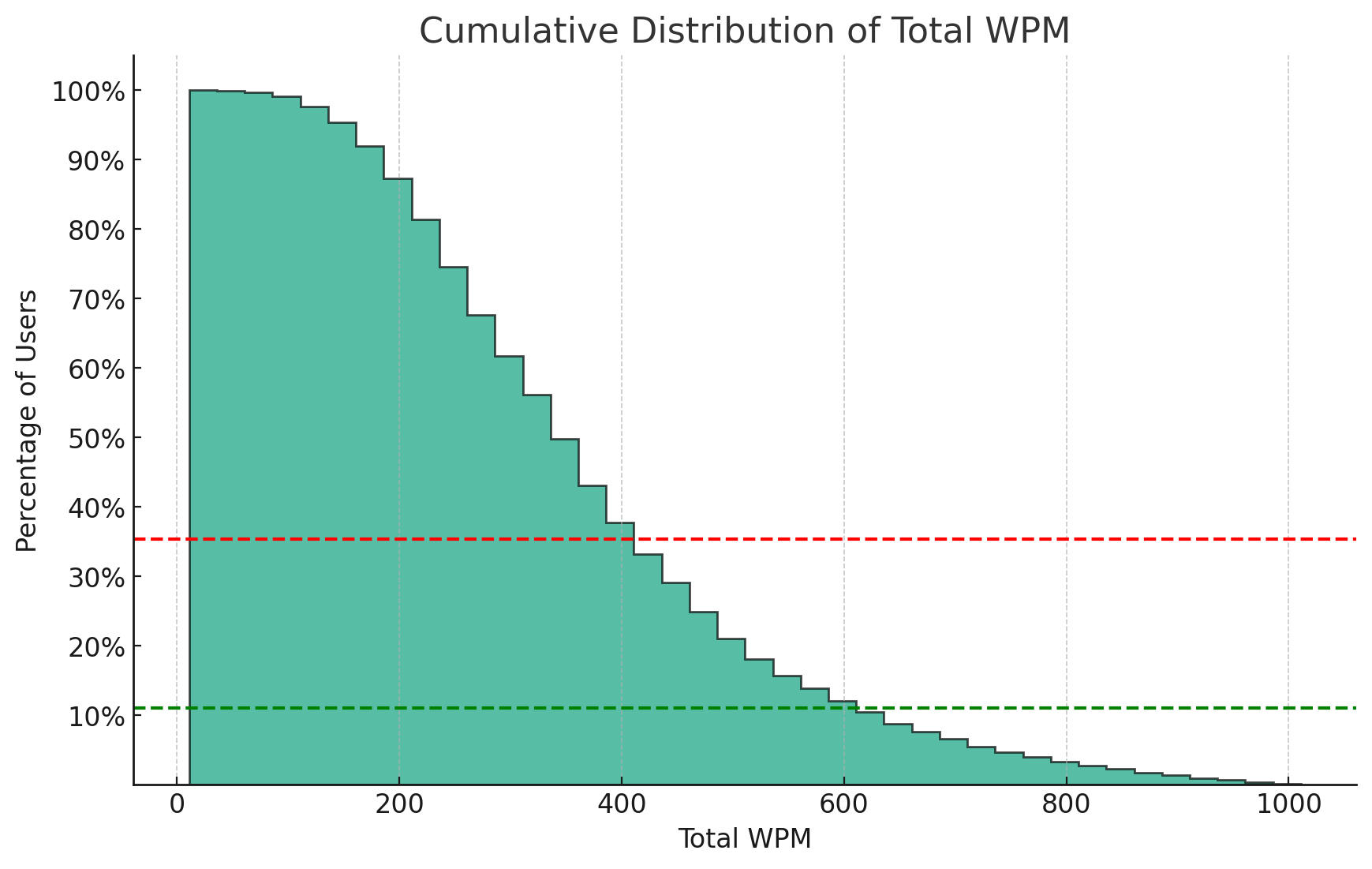
Reading Speed Seems Independent of Comprehension Across Most Adults
Next, we were interested in how reading speed relates to reading comprehension across the adults in our dataset. Do adults with faster readings speeds have higher or lower comprehension?
We apply the same 70% reading comprehension minimum as the study that looked at reading speed and comprehension for students in grades 2 through 12, and our dataset shrinks from about 2800 people to 1400 people: about half of the people in our dataset scored higher than 70% (in total) on the reading comprehension tests that they took.
Interestingly, people who read with at least 70% comprehension seemed to read at very similar speeds to people who read with less than 70% comprehension.
| Group | 25th Percentile WPM | 75th Percentile WPM |
|---|---|---|
| People with >= 70% comprehension | 233 | 440 |
| People with < 70% comprehension | 224 | 464 |
In fact, there’s zero correlation between reading comprehension and reading speed across individuals in the dataset.
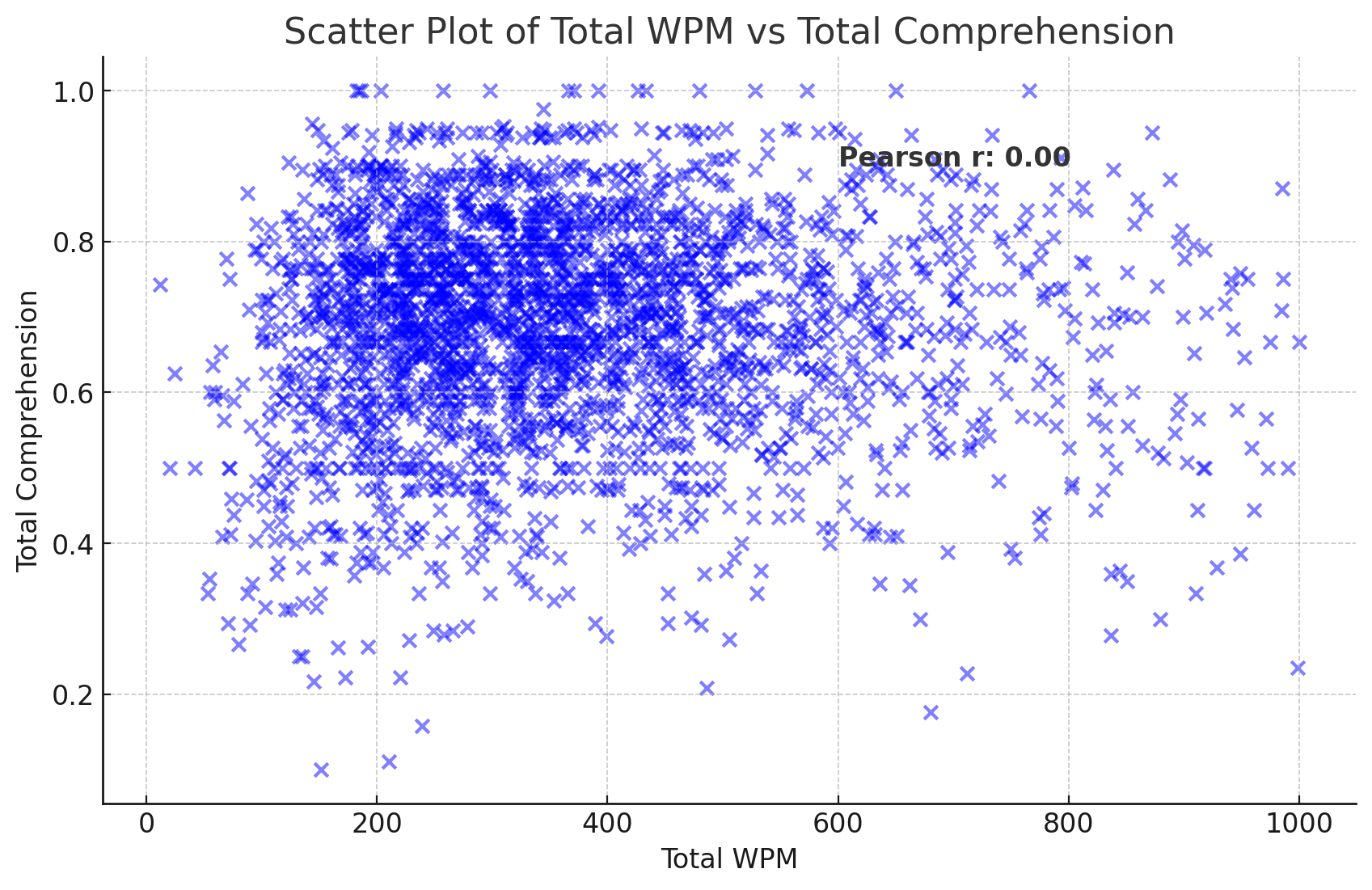
What this means is that, for example, if a person has a higher than average reading speed, say 400 WPM, we can’t really say that they’ll have lower than average, or higher than average, reading comprehension.
This next graph further illustrates how in general, reading speeds aren’t related to reading comprehension (again, across individuals). The graph plots the 25th percentile, median, and 75th percentile reading comprehension levels for people in each WPM / reading speed bucket. We can see that for individuals with reading speeds between 200 WPM and 800 WPM, their comprehension levels tend to range between about 60% and 80%. It’s only at very high, greater than 800 WPM, and low, less than 200 WPM, reading speeds do we see potentially lower comprehension levels, with most comprehension levels ranging from 50% to 70%.
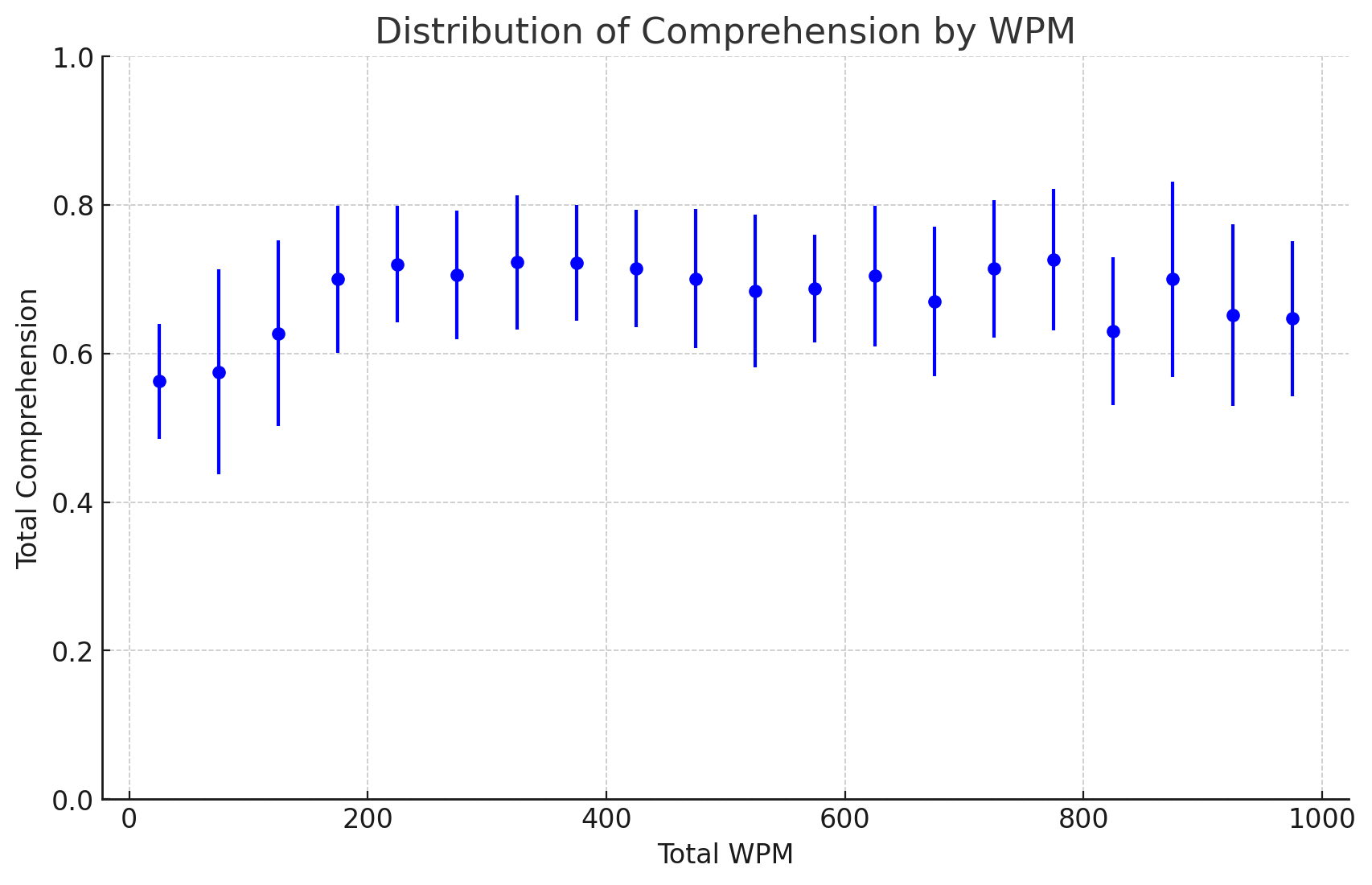
What this suggests is that people who read between 200 and 800 WPM generally have similar reading comprehension levels. People who read faster than 800 WPM might be reading so fast that they’re skipping some information in the text, which results in slightly lower comprehension levels. People who read slower than 200 WPM also have slightly lower comprehension levels, perhaps because they’re developing fluency with the target language: recall that reading speed increases from about 115 WPM to 200 WPM between Grades 2 and 12.
For example, an adult who’s learning English as a second language may have an English language level of an English native-speaking 8th grader. This means that instead of comparing their reading speed to that of an average English native-speaking adult, or ~250-300 WPM, it might be more helpful to compare their reading speed to an average English native-speaking 8th grader, ~165 WPM.
What the Data Means for Improving Reading Speed
In summary, average reading speeds increase from 115 WPM in Grade 2 to about 200 WPM in Grade 12. The average reading speed for adults is around 250 - 300 WPM, and stays relatively constant with age. But there’s large variability in adult reading speeds.
In SwiftRead’s own data, we clearly see individuals who read at an average reading speed of 200 WPM, and those who read four times faster, at 800 WPM, with similar comprehension levels when tested on similar reading passages. Why would someone be able to read four times faster than someone else, while having the same level of comprehension?
As you might imagine, there are many reasons why someone’s reading ability is vastly different from someone else’s. Some factors you cannot control, such as genetics or childhood socioeconomic background. You can influence other factors of reading ability though, like language fluency, reading behaviors, and the usage of tools, like glasses or even reading software, to correct for conditions that affect reading. It’s very possible to improve one’s own reading speed while maintaining comprehension.
The large variation in adult reading speeds also suggests that any reading improvement program needs to be highly personalized. We saw that among adults, reading speeds vary widely from 200 to 800 WPM, even though most reader comprehension levels ranged from 0.6 to 0.8. This suggests that comprehension, and the reading speed required to reach that level of comprehension, is influenced a lot by individual-specific factors, and readers will likely have to adopt personalized strategies to improve reading speed.
How To Improve Your Reading Speed
By now, we hope that you have a better understanding of average reading speeds. If you or a loved one knows their reading speed and comprehension levels (which you can measure with SwiftRead’s free reading speed tests), you can also use that data and the research in this post to see where you stand.
If you have your reading speed data or even if you just feel that you want to be able to read faster (as I, the creator of SwiftRead, did many years ago), the next question becomes: how does someone go about improving their reading skills (which include reading speed and comprehension)? We think it’s as simple as taking the following two steps.
- Better understand how reading works, and learn techniques that can help you read better. As someone who’s interested in reading, you probably understand that knowledge is indeed power. So, one important step towards improving your reading skills is to better understand how reading actually works. Then, you can use that knowledge to help you discover and test various reading strategies and tactics that could help you read better. We’ve created a few guides that bring together the best knowledge and techniques out there to help you read better. Read through them and find what techniques work best for you!
- Use reading software to help you read better. Just as writing technology like Grammarly can help you with grammar, spell-checking, and tone so that you can write better now, reading technology like SwiftRead can help you with reading focus, speed, and comprehension so that you can read better now. Technology is meant to help humans do things better, so give reading software a try.
Found this research interesting? Have more questions? Let us know in the comments below!